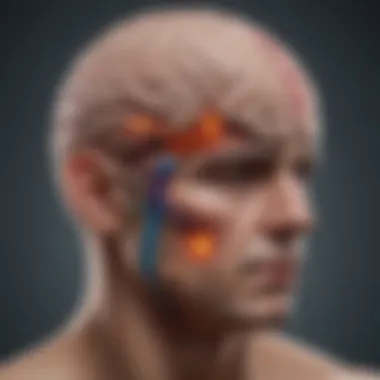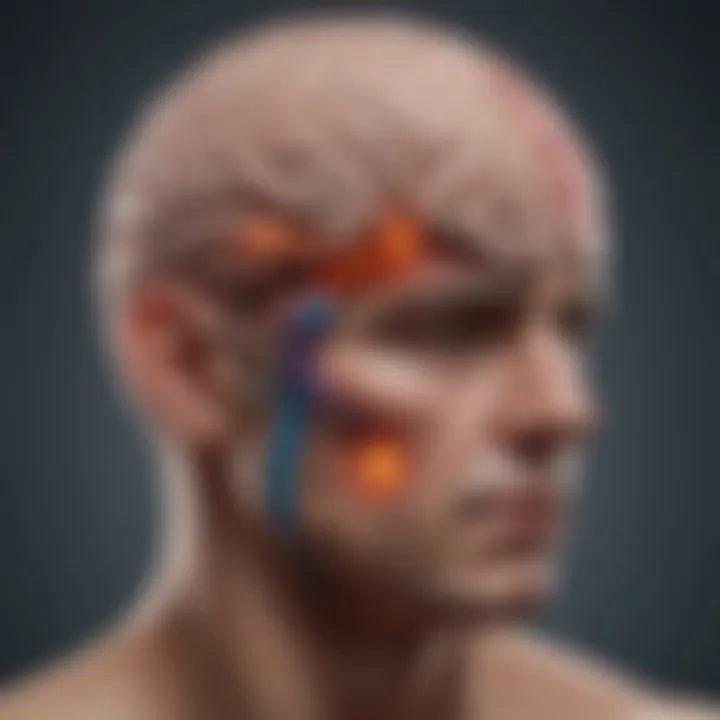Understanding IIH and Its Impact on Migraines


Article Overview
Purpose of the Article
This article aims to explore the intricate relationship between idiopathic intracranial hypertension (IIH) and migraine disorders. By providing an in-depth examination of IIH, including its definitions, symptoms, pathophysiology, treatment options, and its connection to migraines, this work is positioned to enhance understanding in both clinical and research settings. The aim is to clarify how these conditions overlap and influence one another.
Relevance to Multiple Disciplines
The implications of studying IIH extend beyond neurology. This condition has relevance in areas such as ophthalmology, psychology, and even sports medicine. A comprehensive understanding of IIH can aid healthcare professionals across these disciplines in identifying symptoms, diagnosing disorders accurately, and formulating effective treatment plans.
Research Background
Historical Context
The history of idiopathic intracranial hypertension is marked by evolving definitions and treatment approaches. Initially termed "pseudotumor cerebri," it was primarily associated with obesity and female gender. As knowledge expanded, researchers began to recognize its symptoms and diagnostic criteria better.
Key Concepts and Definitions
Idiopathic intracranial hypertension is a condition characterized by increased intracranial pressure without an identifiable cause. Some of its key symptoms include headaches, visual disturbances, and tinnitus. These symptoms often mimic those associated with migraine disorders, making accurate diagnosis challenging.
Key Terms to Note:
- Intracranial Pressure: The pressure within the cranial cavity.
- Migraine: A neurological condition known for recurrent headaches that may be accompanied by nausea, vomiting, and sensitivity to light.
- Visual Disturbances: These may manifest as blurred vision or transient visual obscurations.
"Understanding IIH is critical for correct management of patients presenting with migraine-like symptoms."
"Understanding IIH is critical for correct management of patients presenting with migraine-like symptoms."
The overlapping features of these conditions necessitate careful examination. A well-considered approach can lead to improved patient outcomes and better quality of life for affected individuals.
Preamble to Idiopathic Intracranial Hypertension
Idiopathic Intracranial Hypertension (IIH) is a complex neurological condition that presents significant challenges in diagnosis and management. Understanding this condition is crucial for healthcare professionals, researchers, and educators alike, as it plays a unique role in the landscape of migraine phenomena. IIH is characterized by elevated intracranial pressure without an obvious cause. Its implications extend not only to individual patients but also intersect with broader migraine disorders, thus indicating a need for thorough examination.
The importance of exploring IIH lies in its multifaceted clinical presentation. It shares various symptoms with migraines, complicating differential diagnoses and treatment approaches. Recognizing the impact of IIH on migraine management is essential for improving patient outcomes.
Understanding the specific nuances related to IIH can help clinicians better identify at-risk patients and create tailored treatment strategies. Furthermore, continuous research into IIH and its correlation with migraines holds promise for advancing therapeutic options and outcomes.
In summary, a deep dive into IIH serves as a critical means of equipping professionals with essential knowledge, ultimately benefiting both patient care and ongoing research in neurology.
Defining Idiopathic Intracranial Hypertension
Idiopathic Intracranial Hypertension, commonly referred to as IIH, is defined as increased pressure within the skull that cannot be attributed to any identifiable cause. Diagnosis involves careful assessment of symptoms, such as headaches, visual disturbances, and pulsatile tinnitus. The terminology 'idiopathic' emphasizes the unknown etiology, which sets it apart from secondary causes of elevated intracranial pressure.
Diagnosing IIH often requires a combination of clinical evaluation and diagnostic imaging, typically MRI or CT scans, to rule out other conditions like tumors or lesions.
The lack of clear causative factors in IIH leads to challenges in both understanding and managing the condition effectively. While it is more commonly seen in overweight women of childbearing age, its occurrence can extend beyond these parameters, affecting a diverse demographic.
Historical Context and Progression of Research
The history of Idiopathic Intracranial Hypertension dates back to the early 20th century when the understanding of intracranial pressure was limited. Initially, cases were often misdiagnosed, leading to a lack of attention to IIH as a distinct entity. Over decades, research has advanced, bringing IIH into sharper focus.
Significant studies have illuminated the various aspects of IIH, from its symptoms to management strategies. Awareness has increased, and with it, the recognition that IIH may share a pathophysiological relationship with migraines.
Research has explored the demographics, prevalence, and potential risk factors associated with IIH. As our understanding of the condition has evolved, clinicians have gained insight into effective management and intervention strategies. This ongoing evolution underscores the need for continued research into IIH's characteristics, as well as its implications for migraine disorders.
Pathophysiology of Idiopathic Intracranial Hypertension
The pathophysiology of idiopathic intracranial hypertension (IIH) is critical for understanding how this condition develops and impacts patients. It involves complex interactions between cerebrospinal fluid (CSF) dynamics, venous outflow, and overall intracranial pressure regulation. Investigating these aspects can lead to better diagnosis, management, and treatment options for patients experiencing IIH, especially those who also suffer from migraine phenomena.
Mechanisms of Cerebrospinal Fluid Dynamics
Cerebrospinal fluid dynamics plays a significant role in the pathophysiology of IIH. CSF is produced by the choroid plexus and circulates in the brain's ventricles and the spinal canal. It serves to cushion the brain, remove waste products, and provide nutrients. In IIH, abnormalities in CSF dynamics contribute to increased pressure.
Factors that may disrupt normal CSF flow include:
- Overproduction of CSF: Some studies suggest that patients with IIH may produce CSF at higher rates than normal.
- Impaired Absorption: Conditions affecting the arachnoid granulations can lead to insufficient absorption of CSF.
- Obstruction: Any blockage in the CSF pathways, such as tumors or structural anomalies, can raise intracranial pressure.
Understanding these mechanisms is essential, as they create the foundation for clinical symptoms observed in both IIH and migraine disorders. This interplay of dynamics adds to the complexity of treatment strategies.


Role of Venous Outflow and Intracranial Pressure
Venous outflow is another crucial aspect of the pathophysiology of IIH. The regulation of intracranial pressure relies not only on CSF but also on how effectively blood drains from the brain. When there is compromised venous outflow, it can contribute to elevated intracranial pressure. Several mechanisms may be at play:
- Cranial Venous Sinus Stenosis: Narrowing of the venous sinuses can obstruct blood flow, increasing pressure.
- Intrathoracic Pressure: Factors such as obesity can impact thoracic pressure, leading to increased intracranial pressure through pressure transmission.
- Hydrodynamic Changes: Gravitational and positional effects can alter blood flow dynamics in the brain, influencing pressure levels.
Understanding the interplay between CSF dynamics and venous outflow is vital for developing effective treatment plans. Knowing the underlying causes can guide interventions aimed at relieving pressure.
Understanding the interplay between CSF dynamics and venous outflow is vital for developing effective treatment plans. Knowing the underlying causes can guide interventions aimed at relieving pressure.
Research in this area highlights how interconnected IIH and migraine conditions are. By comprehending the pathophysiology of IIH, clinicians can maintain a more strategic approach in evaluating and managing migraine sufferers, leading to enhanced patient outcomes.
Clinical Presentation of Idiopathic Intracranial Hypertension
Understanding the clinical presentation of idiopathic intracranial hypertension (IIH) is crucial for multiple reasons. Proper identification of this condition impacts not only immediate patient management but also influences long-term outcomes. Given the potential overlap with migraine disorders, recognizing the symptoms of IIH allows clinicians to distinguish these overlapping conditions effectively. A nuanced understanding of IIH symptoms ensures appropriate treatment strategies are implemented early, which can significantly improve patient quality of life.
This section will dissect the common symptoms associated with IIH and the diagnostic criteria that guide clinical practice. Furthermore, it will address the importance of differentiating IIH from other conditions that may present similarly, thus ensuring accurate and timely management of both IIH and migraine disorders.
Common Symptoms and Diagnostic Criteria
The common symptoms of IIH can be varied but often include headaches, visual disturbances, and signs of elevated intracranial pressure.
- Headaches: One of the most prominent symptoms is a headache that often resembles a migraine but is typically characterized by its persistent and pulsating nature.
- Visual Symptoms: Patients may experience transient visual obscurations or even blurred vision due to papilledema.
- Tinnitus: Some may report a ringing in the ears, which can be quite distressing.
- Nausea and Vomiting: These can also accompany the more typical symptoms, leading to significant discomfort.
Healthcare professionals often employ specific diagnostic criteria to confirm a diagnosis of IIH. The Modified Dandy Criteria is a widely accepted framework for diagnosis, which includes the following:
- Headache with presence of symptoms typical of IIH.
- Increased intracranial pressure evidenced by lumbar puncture, showing an opening pressure greater than 250 mm O.
- Normal neuroimaging results excluding other causes of elevated intracranial pressure, such as tumors or brain lesions.
- Absence of secondary causes that can account for the symptoms and findings.
"Recognizing these symptoms and applying the diagnostic criteria promptly can lead to swift interventions, reducing long-term complications associated with IIH."
"Recognizing these symptoms and applying the diagnostic criteria promptly can lead to swift interventions, reducing long-term complications associated with IIH."
Distinguishing IIH from Other Conditions
Differentiating IIH from other neurological conditions is imperative due to the overlapping nature of symptoms. Many individuals with migraine disorders may present with similar headaches or visual disturbances. Here are some distinctions to note:
- Migraine Episodes: Unlike IIH, migraines typically feature aura, light sensitivity, and nausea, which are not characteristic of IIH headaches.
- Neuroimaging Findings: Conditions such as cerebral venous sinus thrombosis will exhibit specific signs on imaging that do not appear in IIH cases.
- Progressive Symptoms: IIH symptoms may worsen over time, while migraine disorders can have episodic nature.
Identifying these nuances assists practitioners in providing precise treatments and avoiding unnecessary interventions for patients with IIH. Furthermore, comprehensive assessments will lead to better patient education and management strategies that prioritize long-term health outcomes.
Migraine Disorders: An Overview
Migraine disorders represent a significant neurological concern that affects millions of individuals worldwide. Their impact is not limited to physical symptoms, as they can influence the emotional and social well-being of those afflicted. Understanding migraine disorders in the context of idiopathic intracranial hypertension (IIH) is imperative, as the two conditions often intertwine, complicating diagnosis and management. This section outlines the essential types of migraine, their characteristics, and the broader epidemiology of these disorders. This background is crucial for comprehending how IIH may exacerbate migraine phenomena.
Types of Migraine and Their Characteristics
Migraine is not a monolithic condition; it presents in various forms, each with distinctive features. The most common types include:
- Migraine without aura: This type is characterized by moderate to severe headache, usually unilateral, lasting between 4 to 72 hours. Common associated symptoms are nausea, vomiting, and photophobia.
- Migraine with aura: This variant includes neurological symptoms like visual disturbances before the headache phase. Aura usually lasts from 20 to 60 minutes and may include visual changes, sensory disturbances, or even speech difficulties.
- Chronic migraine: This category is defined by the occurrence of headaches for 15 days or more per month, with at least eight of those days fulfilling the criteria for migraine. It can lead to significant disability and requires different management strategies.
- Hemiplegic migraine: A rare and severe form involving temporary paralysis or weakness on one side of the body, often accompanied by aura. It is genetically linked and can mimic stroke symptoms, which complicates emergency treatment.
Each type has its own risk factors and triggers, including hormonal changes, stress, certain foods, and environmental factors.
"Recognizing the specific type of migraine can lead to more targeted treatment plans, which is critical for improving patient outcomes."
"Recognizing the specific type of migraine can lead to more targeted treatment plans, which is critical for improving patient outcomes."
Epidemiology of Migraine Disorders
The prevalence of migraine disorders varies geographically, age-wise, and between genders. Studies indicate that migraines affect over 10% of the global population. They are most common among individuals aged 18 to 44 and disproportionately affect women, with a ratio of approximately 3:1 compared to men. Factors contributing to this disparity include hormonal influences and lifestyle factors.
Understanding the epidemiology of migraines helps in clinical settings:
- Health Economic Impact: Migraines can significantly burden healthcare systems and decrease the economic productivity of affected individuals.
- Management Variability: Depending on geographical or demographic factors, pain management strategies may need to be adjusted to provide effective care.
- Risk Factors for IIH: Certain epidemiological trends may hint at increased risks for conditions like IIH, making it essential for healthcare providers to identify patients who may have a more complex clinical picture due to overlapping features.
By delving into migraine disorders, one gains a clearer insight into their significance and complexity, especially regarding their potential correlation with idiopathic intracranial hypertension.
Interconnection Between Idiopathic Intracranial Hypertension and Migraine
The relationship between idiopathic intracranial hypertension (IIH) and migraine disorders is complex and warrants thorough exploration. Understanding this interconnection is crucial for clinicians and researchers alike, as it can lead to better diagnosis and treatment of patients suffering from both conditions. The overlapping symptoms, shared pathophysiological mechanisms, and treatment considerations form a spectrum that requires attention. Misdiagnosis can often occur, leading to inadequate care for individuals who exhibit features of both IIH and migraine.


Several elements play important roles in the understanding of IIH and migraine relationships.
- Shared Symptoms: Many patients with IIH report migraine-like symptoms, making it difficult to differentiate between the two conditions.
- Research Insights: Studies suggest that increased intracranial pressure may trigger or exacerbate migraine events.
- Treatment Implications: Recognizing IIH in patients with migraines influences treatment strategy.
The complexities of this interrelation challenge health professionals to remain vigilant about the diagnostic process. Recognizing the nuances can help tailor effective management strategies.
Shared Symptoms and Overlapping Features
Idiopathic intracranial hypertension and migraine share a variety of symptoms that can complicate clinical assessments. Headaches remain the hallmark of both conditions. However, there are distinctions in their characteristics:
- Onset and Duration: IIH headaches often present with a more gradual onset, while migraine can have sudden triggers.
- Qualitative Differences: IIH-related headaches typically are bilateral and have a pressing quality. In contrast, migrainous attacks often involve unilateral, throbbing pain.
- Accompanying Symptoms: Visual disturbances are prevalent in IIH, such as transient vision loss and visual field defects, not typically observed in migraine patients.
Understanding these overlaps is essential for healthcare providers. Failure to correctly identify these conditions may lead to continued suffering and complicated treatment plans.
Research on IIH and Migraine Correlation
Recent studies have sought to clarify the link between IIH and migraine. Some key findings include:
- Increased Incidence: Individuals with IIH have a higher likelihood of experiencing migraine attacks, emphasizing a potential correlation.
- Pathophysiological Mechanisms: Current research indicates that elevated intracranial pressure can act as a trigger for migraines. This indicates that it may not only be a coincidental finding.
- Interdisciplinary Studies: Some research avenues suggest interdisciplinary approaches to studying IIH and its impact on migraine may yield new insights, particularly in patient management and treatment protocols.
Diagnosis of Idiopathic Intracranial Hypertension in Migraine Patients
The diagnosis of idiopathic intracranial hypertension (IIH) in patients who experience migraines is a complex yet critical issue. Early identification of IIH is essential as it influences treatment strategies and patient outcomes in individuals presenting with migraine-like symptoms. Recognizing IIH can prevent potentially serious complications such as vision loss. Furthermore, understanding the relationship between IIH and migraine can help clinicians make more informed decisions regarding patient management. This section will elaborate on the diagnostic procedures utilized in identifying IIH, along with the challenges faced in clinical diagnosis.
Diagnostic Procedures and Imaging Techniques
To diagnose IIH effectively in migraine patients, medical practitioners rely on various diagnostic procedures and imaging techniques. A thorough patient history and clinical examination often precede imaging. The following are standard diagnostic approaches:
- Lumbar Puncture: Often the first step in diagnosing IIH, a lumbar puncture measures cerebrospinal fluid (CSF) pressure. Elevated CSF pressure generally confirms the suspicion of IIH.
- Magnetic Resonance Imaging (MRI): An MRI scan is essential to exclude other possible causes of elevated intracranial pressure such as tumors or venous sinus thrombosis. Specific findings, such as an empty sella or posterior displacement of the optic nerve, can further support an IIH diagnosis.
- Optical Coherence Tomography (OCT): This non-invasive imaging technique allows for assessment of retinal nerve fiber layer thickness. Changes in these values may aid in detecting optic nerve swelling.
These procedures ensure a comprehensive assessment of the patient's condition. Misdiagnosis can result from overlooking IIH in patients with migraine, leading to extended discomfort or more serious health issues.
Challenges in Clinical Diagnosis
While diagnostic procedures can provide valuable insights, several challenges complicate the diagnosis of IIH in migraine patients. Some of the prominent challenges include:
- Symptom Overlap: Both IIH and migraines share similar symptoms, which can lead to clinical confusion. For instance, headache, visual disturbances, and nausea are prevalent in both conditions, making it hard to determine which is the underlying issue.
- Variability in Presentation: IIH does not present in a uniform way across patients. Some might experience only mild symptoms, while others endure severe headaches or acute visual changes, resulting in different acknowledgment levels.
- Lack of Awareness: There is often insufficient awareness about IIH among healthcare providers, leading to underdiagnosis. Clinicians may not always consider IIH when evaluating patients with headaches, especially in those without classical risk factors.
"A comprehensive diagnostic approach is crucial in identifying both conditions, as misdiagnosis can lead to ineffective treatment plans."
"A comprehensive diagnostic approach is crucial in identifying both conditions, as misdiagnosis can lead to ineffective treatment plans."
- Delayed Diagnosis: The time taken to reach a diagnosis can prolong patient suffering, make case management more complicated and likely contribute to worsened patient outcomes.
Overall, the diagnosis of idiopathic intracranial hypertension in migraine patients represents a critical intersection of two complex conditions. Enhanced awareness and robust diagnostic measures can significantly improve patient care.
Management Strategies for Idiopathic Intracranial Hypertension
The management of idiopathic intracranial hypertension (IIH) is crucial in mitigating its impact on neurological health, particularly in patients who also experience migraines. Understanding these strategies encompasses not only pharmacological options but also non-pharmacological interventions. Effective management can lead to significant improvements in a patient's quality of life by controlling symptoms, reducing intracranial pressure, and ultimately preventing long-term complications.
Pharmacological Approaches
Pharmacological management of IIH primarily focuses on reducing elevated intracranial pressure and alleviating symptoms. Commonly prescribed medications include:
- Acetazolamide: This carbonic anhydrase inhibitor is often the first line of treatment. It works by reducing the production of cerebrospinal fluid (CSF), thereby lowering intracranial pressure.
- Topiramate: This anticonvulsant has been shown to have benefits in reducing headache frequency and altering migraine phenomena, which could be beneficial for patients with both conditions.
- Steroids: Corticosteroids may be utilized in acute cases to decrease inflammation and CSF production, although long-term use is usually avoided due to potential side effects.
In addition to these, diuretics can be considered for managing fluid retention, which may exacerbate symptoms. Monitoring for efficacy and side effects is key. Regular follow-ups allow adjustments to dosage or alternatives if initial treatments do not yield desired outcomes.
Non-Pharmacological Interventions
Non-pharmacological strategies play a significant role in a holistic management plan for IIH. Some of these approaches include:
- Weight Management: For many patients, especially those who are overweight, weight loss can significantly reduce intracranial pressure. A balanced diet and regular exercise are fundamental components of this strategy.
- Lifestyle Modifications: This involves adopting healthier daily practices such as proper hydration, sleep hygiene, and stress management techniques. These changes can alleviate symptoms and improve overall well-being.
- Surgical Options: In cases where medical treatment fails to control symptoms effectively, surgical interventions like lumbar puncture or optic nerve sheath fenestration may be considered. These procedures aim to alleviate pressure on the brain and optic nerves.
Managing IIH requires an individualized approach that takes into account the specific needs and conditions of each patient. Collaboration between neurologists, dietitians, and primary care providers is essential for optimal outcomes.
Managing IIH requires an individualized approach that takes into account the specific needs and conditions of each patient. Collaboration between neurologists, dietitians, and primary care providers is essential for optimal outcomes.
Impact of IIH on Migraine Management


The relationship between idiopathic intracranial hypertension (IIH) and migraine is crucial in understanding how to manage these conditions effectively. Recognizing how IIH influences migraine symptoms and treatment strategies can lead to improved outcomes for patients. It is essential to consider IIH's unique characteristics when developing a treatment plan for migraines, as these two conditions can interact in complex ways.
Considering IIH in Migraine Treatment Plans
When creating treatment plans for migraines, it is vital to assess the possibility of underlying IIH. Migraine sufferers may experience heightened migraine symptoms if they have IIH. This link stems from the increased intracranial pressure associated with IIH, which can exacerbate the intensity and frequency of migraines. Addressing IIH in treatment plans can lead to a more tailored and effective approach.
The implications of IIH on migraine treatment can be summarized as follows:
- Personalized Treatment Options: If IIH is diagnosed, treatments may need to focus on reducing intracranial pressure in addition to typical migraine management. This dual approach can include the use of diuretics, like acetazolamide, which is effective in treating IIH.
- Monitoring Symptoms: Clinicians should regularly monitor patients for signs that might indicate worsening IIH, such as visual disturbances or increased headache frequency. Recognizing these changes early can lead to timely interventions.
- Collaborative Care Models: Coordination between neurologists and other specialists is necessary. Neurologists may focus on migraine, while other healthcare providers can assist in managing IIH, creating a rounded treatment plan.
Outcomes and Effectiveness of Combined Treatments
The effectiveness of managing both IIH and migraines through combined treatments varies. However, a multi-faceted approach can produce significantly better outcomes.
Several studies indicate that patients receiving comprehensive treatment strategies achieve the following:
- Reduction in Migraine Frequency: Studies show that addressing IIH symptoms can lead to a decrease in the occurrence of migraines. By directly managing intracranial pressure, patients often report fewer headache days per month.
- Improved Quality of Life: Patients often experience a better overall quality of life when both conditions are effectively managed. Less frequent and severe migraine attacks allow for increased daily functioning.
- Long-term Management Success: Continued coordination between treatment strategies improves long-term health outcomes. Patients benefit from ongoing assessments and adjustments to their management plans based on their individual responses to treatment.
Managing IIH in tandem with migraines necessitates a thoughtful, multifaceted approach, enhancing patient outcomes and overall quality of life.
Managing IIH in tandem with migraines necessitates a thoughtful, multifaceted approach, enhancing patient outcomes and overall quality of life.
Thus, the impact of IIH on migraine management highlights the need for an integrated care approach that acknowledges the complexities of these conditions. Being sensitive to the interaction between IIH and migraine can streamline treatment and promote symptomatic relief.
Future Directions in Research on IIH and Migraine
The future of research on idiopathic intracranial hypertension (IIH) and its association with migraines holds significant promise for enhancing our understanding of these complex conditions. As new technologies and research methodologies emerge, they can provide insights that may fundamentally alter our approach to diagnosis and treatment. By focusing on unexplored facets, researchers can identify links that have previously eluded traditional studies.
Understanding the nuances of IIH and migraines can lead to better patient outcomes. The exploration of genetic factors, for instance, could reveal why some individuals develop these conditions while others do not. Additionally, examining the impact of lifestyle factors, such as diet and exercise, on IIH symptoms and migraine triggers can further shape treatment strategies.
Continued exploration in IIH research will likely uncover novel treatment pathways that integrate more holistic approaches, leading to improved management guidelines for clinicians.
Continued exploration in IIH research will likely uncover novel treatment pathways that integrate more holistic approaches, leading to improved management guidelines for clinicians.
Emerging Technologies and Techniques
Technological advancement plays a pivotal role in the progression of research related to IIH and migraine. MRI and CT imaging technologies provide deeper insights into structural changes in the brain associated with IIH. Recently developed techniques, such as advanced neuroimaging, enable more precise measurements of intracranial pressure and cerebrospinal fluid dynamics.
Moreover, the integration of artificial intelligence and machine learning can refine data analysis. These technologies can process vast amounts of research data to uncover hidden patterns. By identifying specific biomarkers, clinicians may be better positioned to diagnose IIH in migraine patients more accurately.
Potential for Interdisciplinary Studies
The relationship between IIH and migraines is complex, underscoring the need for interdisciplinary studies. Combining insights from neurology, pharmacology, and psychology can yield richer understanding of how IIH influences migraine presentations. Collaboration among experts from different fields can foster comprehensive research methodologies, leading to holistic treatment options.
Furthermore, understanding the psychosocial aspects of living with these conditions is crucial. Interdisciplinary studies might address how mental health influences both IIH and migraines and vice versa, leading to more effective therapeutic interventions.
Epilogue
The conclusion signifies the closure of our understanding of idiopathic intracranial hypertension (IIH) and its relation to migraine phenomena. It emphasizes pivotal elements such as the complexity of symptoms shared between the two conditions. Recognizing these overlaps is crucial. Clinicians must be aware of the diagnostic challenges faced when IIH and migraine present concurrently. This understanding aids in informed decision-making regarding patient management strategies.
Equally important is the synthesis of research findings discussed throughout the article. A comprehensive review serves not only to summarize but also to elevate practical applications in clinical settings. For researchers, it highlights gaps in knowledge, thus guiding future investigations. Focusing on such intersections could lead to innovative treatments and better patient outcomes.
The synthesis of IIH and migraine research can illuminate patient management strategies, unveiling tailored approaches for individuals.
The synthesis of IIH and migraine research can illuminate patient management strategies, unveiling tailored approaches for individuals.
Moreover, the evolution of diagnostic techniques and treatment modalities reflects ongoing progress in understanding these conditions. Continuous education and collaboration across specialties are paramount. The interrelated nature of IIH and migraine necessitates multidimensional approaches.
Ultimately, the conclusion underscores the necessity of a persistent and thorough examination of IIH and its implications on migraine phenomena, establishing a pathway for improved clinical practices and patient care.
Summary of Findings
This article provided an extensive exploration of idiopathic intracranial hypertension and its contributions to migraine phenomena. It covered the following key points:
- Definitions and historical context of IIH.
- Pathophysiological mechanisms and their clinical manifestations.
- Common symptoms that overlap with migraines, challenging existing diagnostic processes.
- Management strategies that integrate treatments for both conditions.
- Potential research areas that could advance understanding further.
By integrating these elements, a clearer perspective is established for both clinicians and researchers. This can foster more effective diagnostic protocols and treatment strategies for patients experiencing these overlapping neurologic disorders.
Importance of Continued Research
The realm of idiopathic intracranial hypertension and migraines remains a dynamic field, ripe for further inquiry. Continued research is vital for several reasons:
- Understanding Mechanisms: Investigating the underlying pathophysiology can provide insights into causative factors. This knowledge can improve diagnostic accuracy.
- Innovative Treatments: As the knowledge base expands, new drug therapies and non-pharmacological approaches could emerge.
- Patient Quality of Life: Enhancing methods of management actively contributes to patient care, ultimately improving the lives of many.
- Interdisciplinary Collaboration: Bridging gaps between neurology, radiology, and pain management may yield comprehensive strategies that address both conditions effectively.
However, research challenges do persist. Funding constraints and the need for collaborative studies can hinder progress. Addressing these obstacles is essential for the advancement of understanding in this critical area of health.



